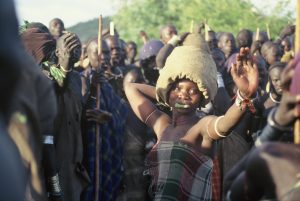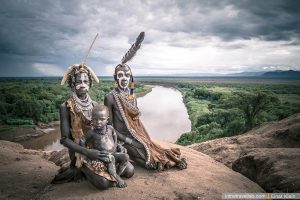Human History As We See It Today


It’s not really known, or should I say confirmed how long humans have lived here on Mother Earth, but it’s estimated that the species “human” were here about 6 million years ago in some form. One of the oldest human skeletal finds is “Lucy”, who is about 3.2 million years old. She was found in a country in Africa called Ethiopia (1).
Rumour has it that we humans started life here on the continent of Africa. Our scientist tell us that all DNA can be traced back to Africa, and that the oldest fossils found to-date come from Ethiopia.
So I think this is a good place to start. Lets take a little peak into some ancient cultures that are still part of this environment.
“Research by geneticists and archaeologists have traced the origins of modern homo-sapiens back to a single group of people who managed to cross from the Horn of Africa into Arabia. From there they went on to colonise the rest of the world.” (2)
“Genomic DNA contains the biochemical instructions for building a human, and resides within the nuclei of our cells.” (3)
Hence the knowing that all DNA can be traced back to Africa.

As you can see from the map of Africa, Ethiopia is right on the Horn of the continent. This country is very rich in diversity.
She is home to about 80 different cultures, some of which have changed very little in time.
I thought it would be fun to have a look at a couple of these ancient cultures just to get a taste of where we may have come from.
The Omo River, which begins in the highlands near Adis Abeba (Addis Ababa) and runs down the central western side of the country into Lake Turkana, is home to some of the worlds oldest known cultures. In particular the southern part of the country known as Southern Nations, Nationalities and peoples (SNNP), in the Ethiopian Plateau. This is where many of these tribes still live and practise their traditional ways.
I’ve chosen 3 tribes that still practise these traditional ways, the Mursi, Hamar and Karo who live in the lower Omo River region bordering on Northern Kenya and Southern Sudan. Although they are their own individual tribes they share some similar customs and ways of life. They all raise cattle, hunt and grow crops. Cattle being the most important aspect of their wealth, many of their traditions revolve around cattle. The more cattle they have, the richer they are, hence the practise of cattle raiding from neighbouring tribes.
MURSI TRIBE

“It’s like a bridge between the individual and society, the biological self and the social self.” (4)
The Mursi tribe are famous for wearing clay or wooden plates in their bottom lip or earlobes. The mothers cut their child’s lip or lobe open when they are between 15 and 16 with either a thorn or a knife.
The wound is kept open with a wooden plug until it heals. This is a rite of passage, which can be seen as an expression of social adulthood and reproductive potential.
Stick or pole fighting known as “donga” duels and braclet fighting known as “ula” are another important ritual.
Donga fighting takes place between the Mursi men.
The winner of this fight can then choose his bride.

Ula fighting is performed between women; from this practise the men can see how strong the women are which helps them decide who to marry.

A girl with a torn bottom lip, earlobe, or multiple scars on her forehead might be taunted as being weak.
Both donga and ula competitions are a way of conveying courage and sociability among children and adults. Young boys are taught to fight with sticks or poles and young girls are taught to strike with bracelets. This is a way for them to learn how to defend themselves, and to convince others of their “suitability and strength for adulthood, marriage and reproduction”. All this is looked upon as gaining a higher status. (5)
HAMAR & KARO TRIBES
Similarities between the Hamar and Karo tribes, they practise the Bula or Pilla initiation ritual where young men prove they have now reached manhood. This is done by jumping over a row of cattle six times consecutively without falling. If successful the lad is then ready for marriage. (6)
Karo tribe ritual

Intricate Body art, elaborate head dresses and scaring ones body are other fascinating practices by the Karo and Hamar. These are rituals that signify beauty and significant events within the community.

The Karo paint their bodies with natural local resources such as white chalk, charcoal, coloured ochre, yellow mineral rock and pulverised iron ore, and change their designs daily. Both men and women use a clay to plaster on their heads creating hairstyles and headdresses signifying bravery and beauty.
Hamar tribal ritual

The Hamar are famous for scarring their bodies to indicate the warrior in them.
The revered warrior Gormari is known as one of the most decorated Hamar men claiming to have killed more than three times.
“When I was getting my first scars, the process was extremely painful. But I couldn’t show my fear. I wanted people to know that I am a killer!

Body scaring is another important custom that is practised both with men and women signifying bravery and strength.
I would insult myself under my breath if I winced while being cut, yet all the while I was thinking that I would be a hero of my village and that took my mind off the pain. My friends were also there to support me, and they would insult me from time to time to get me through it. I want you to know that I didn’t get these scars to impress the ladies. I did it because it was traditional and I wanted to honour my ancestors.”
Gormari continued,
“Five years ago, I killed a Borana and earned my chest scars. Three years later, I killed a Galeb and that’s why I got scarred on my left arm. A short time later, I was in a conflict with the Galeb again and I was the one who killed him. That is why I received the scars on my right arm. The Hamar respect me and know me because of my scars. Typically only elders get respect, but because I killed our enemy, all of the village elders respect me and that is personally important for me. But what I haven’t told you is that I wounded six other enemies and I also took their guns. You get more cuts if you perform a feat like this, and that is why I have still more scars under my armpit”. (7)
Hamar women will also be scared; married woman may agree to scarring their body as her husband has no more room on his body.
Alternatively, an unmarried woman may become scarred as a means of attracting a husband, baring the “beauty marks of the Hamar.”
One Hamar woman named Gule stated:
“When you bleed, you lose weight and become weak. But the women still get scars, not because we are forced to, but because we want to.” (8)


- http://www.bbc.com/earth/story/20141127-lucy-fossil-revealed-our-origins
- http://www.telegraph.co.uk/news/science/science-news/5299351/African-tribe-populated-rest-of-the-world.html
- http://www.bbc.com/news/science-environment-29213892
- http://afritorial.com/tribe-the-unusual-mursi-of-ethiopia/
- http://www.mursi.org/introducing-the-mursi/duelling/copy_of_duelling
- http://afritorial.com/tribe-faces-of-the-karo/
- http://www.larskrutak.com/ethiopias-last-frontier-the-bloody-world-of-the-hamar-tribe/
- http://www.larskrutak.com/ethiopias-last-frontier-the-bloody-world-of-the-hamar-tribe/